The flowered Transylvanian enamel
The herma got a beautiful wire-enamelled front, which belongs to the first Hungarian experiences of gilded enamelling techniques. In
The Hungarian wire-enamelling is such a unique technique, that it differs from any other wire-enamelled methods, for example Byzantine compartment-enamelling, and it even differs from Greek, Russian, and Persian wire-enamelling techniques. There are 100 years between the practice of the above-mentioned techniques, and the estab-lishment of the Hungarian wire-enamelling, which also justifies the fact that there is no co-relation with them. The different effects of the techniques also proves their non-relation: the style and characteristics of the Byzantine compartment-enamel works is purely flat decoration, while the main characteristic of the Hungarian wire-enamelling is the flat-relief, which appear along the lines of the ornament wires.
Matthew Corvin’s (1458-1490) strong personality was dominating in the second half of the 15th century. At the first years of his reign, the warlike humanist king was –according to history-writer Antonio Bonfini-, “only cared about his horses and weapons”. Matthew showed great pomp and luxury in his royal court at times of peace treaties, royal meetings, or when he was welcoming for-eign ambassadors.
He never missed the chance to make these royal events even more famous and prestigious with the enamel works of his unbelievably rich treasury. Matthew’s personal attachments to the monarchs of Milano, Venice, Ferrara, Fizence, Urbino, and Napoli were crucial in the development of the Hungarian Renaissance.
Just after Hungary has recovered from the destruction of the Mongol invasion, it was facing even bigger problems: the Turkish invasion.
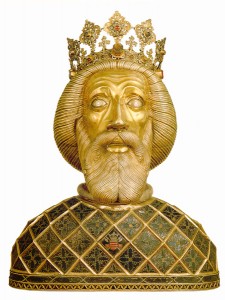
Cathedral Treasury, Győr
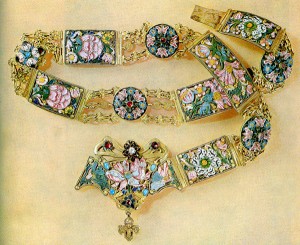
2. photo Female belt. Transylvania, XVII. ct.
Hungarian National Museum, Budapest
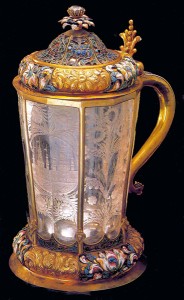
3. photo Trophy with a lid.
Our defeat and surrender at the battle of Mohacs started a very bad period for 150 years. The country was devided into three parts.
Art life was very slow to start. The Renaissance made way in Transylvania and in the
The old Hungarian enamellists used two colour tones. These tones can be grouped into two colour scales. The first one is the so-called “warm” colour scale: it contains the colours of red, white, green, (blue, violet), brown and black; and was used in the 15th century. The other scale is the “cold” scale: white, green, blue, violet, and in very rare cases, yellow. The warm colour scale was mainly used in Upper and
The application of the flower-patterned, checkered ’’Transylvanian enamelling” started at the time of the Renaissance, and provided many possibilities in the field of jewellery-production.
We can often read about ”flowered” trophies and cups in the 16-17th century inventories, last wishes, and legacy documents of the lords (3.-4. photo). Some of these meant the embossed flowers on the pots, but most of them referred to beautiful enamel-decorated parts. The guilded silver surface is covered with filigree web, the enamel decoration was inserted by screws unit by unit by the maestro. The whole surface of the pot is covered by enamel. The unknown Transylvanian enamellist inserted an enamelled, pearl stigmed, statuesque flower bouquet with a pearl stigma on the top of the lid.
We can also claim that, in the age of the gothic, there was little difference in style between the Transylvanian enamelling, and that of the rest of
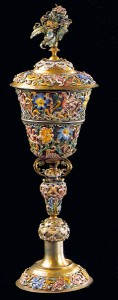
4. photo Trophy. Transylvania, XVII. század
Hungarian National Museum, Budapest
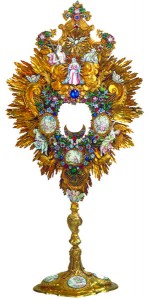
5. photo Monstrancy. Szilassy János, Lőcse, 1767
Hungarian National Museum, Budapest
The flower was the main motif of the Transylvanian and Upper Hungarian enamellists. The similarity in style between the Transylvanian enamel did not cease to exist at the time of the separated Transylvanian principality, it has been sustained primarily by the easily movable enamel masterpieces, the wandering maestros and by their lads. In the 17th century, the Hungarian enamel artists produced high quality products under the aegis of baroque style. Sebestyen Hann, the unique talent of embossing, Janos Szilassy, the master of Hungarian laminated enamelling, and Istvan Brózer were, among others, the representatives of the era.
A general decline of applying enamelling can be felt from the end of the 17th century. It was to be feared that even the technology of enamelling will be forgotten. It cannot be claimed, however, that there wasn’t any goldsmith who used enamelling for the decoration of his products. Under the Turkish rule, the goldsmith’s moved to Transylvania and
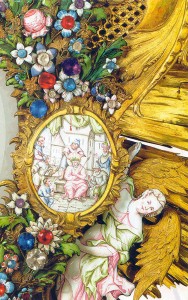
6. photo Part of the Monstrancy
Hungarian National Museum, Budapest
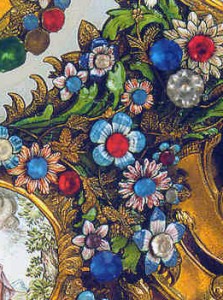
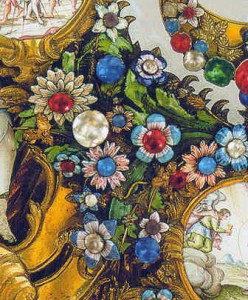
7 - 8. photo Part of the Monstrancy
Hungarian National Museum, Budapest
Ötvös Nagy Ferenc
Goldsmith and museologist
A mappában található képek előnézete Virágos erdélyi zománc-IT WAS MADE LIKE THIS





cialis generic paypal
(arrondurf, 2021.06.13 07:37)